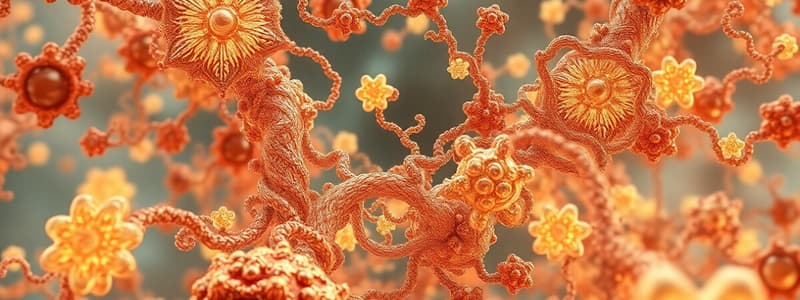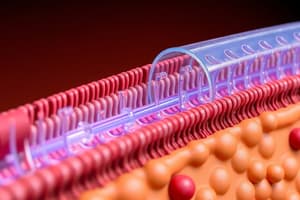Podcast
Questions and Answers
What is a key characteristic of simple diffusion?
What is a key characteristic of simple diffusion?
- Utilizes membrane proteins for transport
- Requires energy to move substances
- Occurs down a concentration gradient (correct)
- Moves substances against a concentration gradient
Which type of membrane protein is always open for the transport of substances?
Which type of membrane protein is always open for the transport of substances?
- Carrier proteins
- Aquaporins
- Gated channel proteins
- Un-gated (leak) channels (correct)
What role do carrier proteins play in facilitated diffusion?
What role do carrier proteins play in facilitated diffusion?
- They only transport ions across the membrane.
- They require energy for conformational changes.
- They act like tunnels for passive transport.
- They allow the passage of large uncharged molecules. (correct)
Why is water able to cross cell membranes more quickly than some other polar molecules?
Why is water able to cross cell membranes more quickly than some other polar molecules?
What distinguishes facilitated diffusion from simple diffusion?
What distinguishes facilitated diffusion from simple diffusion?
What does osmosis primarily refer to?
What does osmosis primarily refer to?
Which of the following statements about simple diffusion is true?
Which of the following statements about simple diffusion is true?
What is the main factor that affects the rate of simple diffusion?
What is the main factor that affects the rate of simple diffusion?
What occurs when an animal cell is placed in a hypotonic solution?
What occurs when an animal cell is placed in a hypotonic solution?
Which term describes the movement of water towards an area of higher solute concentration?
Which term describes the movement of water towards an area of higher solute concentration?
In plant cells, what is the term for the pressure created by water entering the cell without causing rupture?
In plant cells, what is the term for the pressure created by water entering the cell without causing rupture?
What is the result of placing a plant cell in a hypertonic solution?
What is the result of placing a plant cell in a hypertonic solution?
Which process requires energy for the movement of molecules against their concentration gradient?
Which process requires energy for the movement of molecules against their concentration gradient?
What characterizes receptor-mediated endocytosis?
What characterizes receptor-mediated endocytosis?
What happens during exocytosis?
What happens during exocytosis?
What is typically found in regions of the membrane specialized for receptor-mediated endocytosis?
What is typically found in regions of the membrane specialized for receptor-mediated endocytosis?
During osmosis, how does water move in relation to solute concentration?
During osmosis, how does water move in relation to solute concentration?
What is the role of the sodium-potassium pump?
What is the role of the sodium-potassium pump?
What term describes the shrinking of the plasma membrane away from the cell wall in plant cells?
What term describes the shrinking of the plasma membrane away from the cell wall in plant cells?
Which of the following best describes hypotonic solutions?
Which of the following best describes hypotonic solutions?
How does bulk membrane transport differ from osmosis?
How does bulk membrane transport differ from osmosis?
Flashcards
Simple Diffusion
Simple Diffusion
The movement of small and non-polar substances across a cell membrane without the assistance of membrane proteins.
Passive Transport
Passive Transport
A type of passive transport where molecules move across a semi-permeable membrane down their concentration gradient, from an area of high concentration to an area of low concentration.
Transport Proteins
Transport Proteins
Proteins embedded in the cell membrane that assist in the movement of molecules across the membrane.
Channel Proteins
Channel Proteins
Signup and view all the flashcards
Aquaporins
Aquaporins
Signup and view all the flashcards
Carrier Proteins
Carrier Proteins
Signup and view all the flashcards
Osmosis
Osmosis
Signup and view all the flashcards
Equilibrium
Equilibrium
Signup and view all the flashcards
Isotonic
Isotonic
Signup and view all the flashcards
Hypotonic
Hypotonic
Signup and view all the flashcards
Hypertonic
Hypertonic
Signup and view all the flashcards
Osmotic Lysis
Osmotic Lysis
Signup and view all the flashcards
Crenation
Crenation
Signup and view all the flashcards
Turgor Pressure
Turgor Pressure
Signup and view all the flashcards
Turgidity
Turgidity
Signup and view all the flashcards
Plasmolysis
Plasmolysis
Signup and view all the flashcards
Active Transport
Active Transport
Signup and view all the flashcards
Pump
Pump
Signup and view all the flashcards
Sodium-Potassium Pump
Sodium-Potassium Pump
Signup and view all the flashcards
Bulk Membrane Transport
Bulk Membrane Transport
Signup and view all the flashcards
Phagocytosis
Phagocytosis
Signup and view all the flashcards
Pinocytosis
Pinocytosis
Signup and view all the flashcards
Study Notes
Simple Diffusion
- Small, non-polar substances move across membranes without assistance.
- Movement is down a concentration gradient (high to low).
- No energy required.
- Continues until equilibrium is reached.
- Also known as simple transport.
- Very small, non-polar molecules (like O₂ and CO₂) move easily.
- Non-polar steroid hormones and drugs also cross readily.
- Water and glycerol, though polar, can move relatively quickly due to their small size.
- Large molecules and ions have very slow movement across membranes.
Facilitated Diffusion: Channel and Carrier Proteins
- Similar to simple diffusion, it's passive transport across a semi-permeable membrane until equilibrium is reached.
- A key difference: it involves transport proteins.
Channel Proteins
- Act like tunnels.
- Can be ungated (always open) or gated (can open/close).
- Moves small, dissolved charged molecules (like ions).
- Charged particles need help crossing the hydrophobic core.
- Aquaporins are a specific type of channel protein that facilitate water movement.
Carrier Proteins
- Act like revolving doors.
- Undergo conformational changes to move molecules.
- Move a variety of substances from charged particles to large, uncharged ones (like glucose).
Osmosis
- Water movement across a semi-permeable membrane.
- In cells, aquaporins facilitate water movement.
- Moves from high water concentration to low water concentration (or to dilute solutes).
- Water moves in the opposite direction of solute movement.
- Tonicity refers to the osmotic pressure due to solute concentration differences across a membrane, influenced by non-penetrating solutes. It refers to the concentration of solutes in the environment surrounding the cell (external).
Osmosis in Animal Cells
- Isotonic: Equal water movement in and out. Cells are in equilibrium.
- Hypotonic: Lower solute concentration outside the cell. Water moves into the cell, causing it to swell and potentially burst (osmotic lysis).
- Hypertonic: Higher solute concentration outside the cell. Water moves out of the cell, causing it to shrink (crenation).
Osmosis in Plant Cells
- Plant cells have cell walls, affecting osmotic effects.
- Isotonic: Cells are flaccid (lacking firmness). Water movement is in equilibrium but does not provide the pressure necessary for support.
- Hypotonic: Cell wall prevents bursting, resulting in turgor pressure and turgidity.
- Hypertonic: Cell membrane and cytoplasm shrink (plasmolysis) away from the cell wall, but the cell wall retains shape.
Active Transport
- Moves molecules against their concentration gradient (low to high).
- Requires energy in the form of ATP.
- Uses transport proteins called pumps.
- ATP changes the pump's conformation, allowing specific molecules to enter/exit against their gradient.
Types of Pumps
- Often function similarly to carrier proteins but move molecules against the concentration gradient, requiring energy.
- Can be coupled to move two molecules against their concentration gradient.
Sodium-Potassium Pump (Na-K Pump)
- Located in the plasma membrane.
- Simultaneously moves 3 Na+ ions out and 2 K+ ions into the cell.
- The pump oscillates between two conformational states to perform this.
Bulk Membrane Transport
- Transports molecules in large quantities.
- Used for molecules that are too large or polar to pass through the membrane.
- Involves folding of the cell membrane to create vesicles.
- Includes endocytosis (phagocytosis, pinocytosis, receptor-mediated endocytosis) and exocytosis.
Endocytosis
- Phagocytosis: "Cellular eating"; ingestion of cells or large particles. Used for feeding in simpler forms of life and defense in higher organisms.
- Pinocytosis: "Cellular drinking"; ingestion of dissolved materials (unspecific).
- Receptor-mediated endocytosis: Specific intake of molecules that bind to receptors on the cell surface. Ligands bind to receptors, membrane pinches to form a vesicle, ligands detach from receptors, vesicle pinches into two parts – free ligand and empty receptor, ligands fuse with lysosomes, and receptors are returned to the cell surface
Exocytosis
- Movement of materials from inside the cell to the cell surface within membrane-bound vesicles.
- Vesicles form from the Golgi or endocytosis.
- Reverse of endocytosis.
- Functions in secretion, recycling membrane proteins, and restoring the cell membrane.
Studying That Suits You
Use AI to generate personalized quizzes and flashcards to suit your learning preferences.




